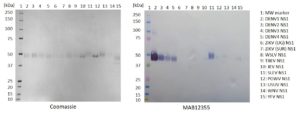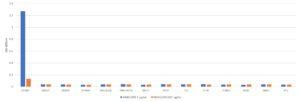
Western Blot: 100ng of each antigen was used for SDS-PAGE, in reduced form. Proteins were transferred using Transblot for 7 minutes at 25V. 5% dry milk in PBS-T was used as blocking buffer and dilution buffer for antibodies. Primary antibodies are given below, and goat anti-mouse-IgG-HRP secondary antibody (Biorad 103005) was used at 1:1000. All steps were carried out for 1h at room temperature with gentle rocking. KPL Membrane TMB was used for detection. Development time 30 seconds. Antibody detected NS1 protein for all four Dengue virus serotypes and St. Louis encephalitis virus (SLEV).

ELISA: All NS1 antigens coated at 0.5µg/ml in DPBS for 2h at RT. Plate washed 1X 300µl/well TBS + 0.1% Tween20, blocked 300µl/well DPBS+1% BSA for 1h. Antibody diluted to 1.0µg/ml and 0.01µgml in DPBS + 1% BSA + 0.05% T20. Added at 100µl/well, incubated shaken 2h room temperature. Plate washed 3X 300µl/well TBS-T wash buffer. Biorad goat anti-mouse IgG-HRP (103005) secondary antibody diluted 1 in 2500 in DPBS/1%BSA/0.05%T20, added at 100µl/well, incubated shaken 1h room temperature. Plate washed 6X 300µl/well TBS-T wash buffer. Detection by Europa TMB substrate, added at 100µl/well and the plate developed for 3 min. static on the bench. Reaction stopped with 100µl/well 1M HCL and the plate was read within 4 min. at 405nm.
MOUSE ANTI-DENGUE VIRUS NS1 SEROTYPE 1 (BA11)
Mouse anti Dengue virus serotype 1 (BA11) monoclonal antibody recognises the NS1 protein of Dengue virus serotype 1.
PRODUCT DETAILS – MOUSE ANTI-DENGUE VIRUS NS1 SEROTYPE 1 (BA11)
- Mouse Anti Dengue Virus NS1 Serotype 1 (BA11) monoclonal antibody.
- Immugen was a pool of NS1 proteins from all four Dengue virus serotypes.
- This antibody recognises DENV1 NS1 protein. It shows no cross-reactivity in ELISA with NS1 from DENV serotypes 2, 3 or 4, ZIKV, WSLV, TBEV, JEV, SLEV, POWV, USUV, WNV and YFV.
- In western blot it detects NS1 for all four DENV serotypes and St. Louis encephalitis virus (SLEV) NS1.
BACKGROUND
Dengue is caused by one of four different serotypes of small RNA viruses in the family Flaviviridae, DENV1–4. NS1 is a major non-structural protein expressed by the Dengue virus. The NS1 monomer is a glycosylated protein of approximately 45kD, which associates with lipids and forms a homodimer inside infected cells. It is necessary for viral replication, and is also secreted into the extracellular space as a hexameric lipoprotein particle, which is involved in immune evasion and pathogenesis by interacting with components from both the innate and adaptive immune systems, as well as other host factors. NS1 is one of the major antigenic markers for viral infection with Dengue. It is secreted from infected cells and is found in serum at detectable levels that overlap with peak viremia and RNA detection. This also coincides with the start of detectable IgM in acute primary cases and IgG in acute nonprimary cases. Elevated levels of serum NS1 directly indicates increased viral burden and indicates a positive correlation between viremia and NS1 profiles (Ambrose et al., 2017).
Dengue fever is ranked by the World Health Organization (WHO) as the most critical mosquito-borne viral disease, globally. More than 40 percent of the world’s population, in more than 100 countries are at risk of dengue infection. The most significant dengue epidemics in recent years have occurred in Southeast Asia, the Americas and the Western Pacific. Each year, an estimated 390 million dengue infections occur around the world. Of these, 500,000 cases develop into dengue haemorrhagic fever – a more severe form of the disease, which results in up to 25,000 deaths annually.
With more than one-third of the world’s population living in areas at risk of transmission, dengue infection is a leading cause of illness and death in the tropics and subtropics (WHO for Guidelines for Diagnosis, Treatment, Prevention & Control, 2009). As many as 100 million people are infected yearly. Dengue is caused by any one of four related viruses transmitted by mosquitoes. There are no vaccines available to prevent infection with dengue virus.



